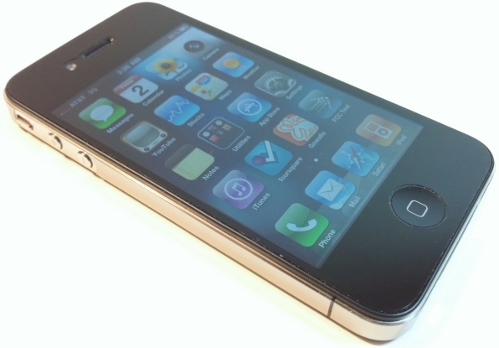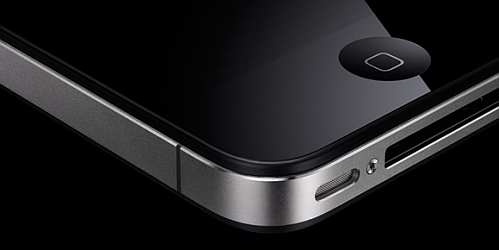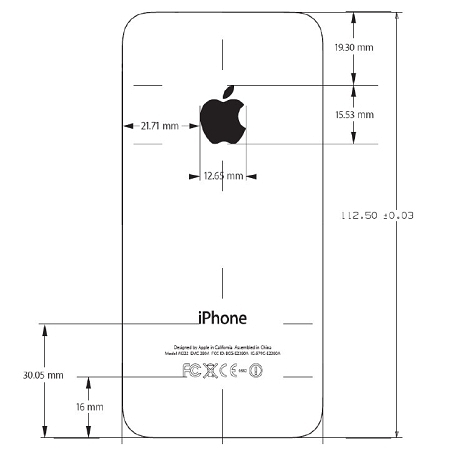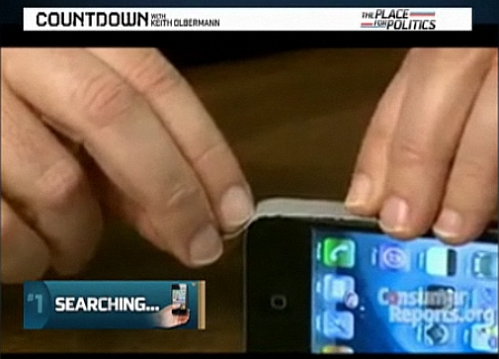Index
![]()

Review: A smartphone that promises it all
In the first half of our iPhone 4 review, we gave a brief historical overview of the iPhone platform since its introduction to the smartphone market in summer 2007, including its booming impact on the global smartphone market over the past three years. We discussed Apple’s design philosophy behind the physical dimensions and aesthetics of the iPhone 4, and we examined the truth behind the much hyped Retina Display.

In this half of the review, we will take a look at the real story of the controversy behind the ill-fated antenna design, internal hardware specifications and upgrades from the iPhone 3GS, the improved backside CMOS camera sensor with LED flash and new front-facing VGA camera, battery life with iOS 4 and multitasking, FaceTime chat, and overall market acceptance since launch day.
Antenna design and controversial reception issue
Unlike the previous three iPhone generations, the iPhone 4 sports a new antenna design that is meant to improve reception and overall call quality. The antenna is a split stainless steel band that runs around the edge of the phone. The shorter, left strip is used for WiFi, Bluetooth and GPS and the longer, right strip is connected to the UMTS/GSM cellular radio for voice and data. In perspective, the design can be viewed as a return to some of the earliest phone designs from the 90s that featured external antenna poles and could be manually raised for improving reception. During Apple’s WWDC 2010 keynote, Steve Jobs exclusively noted that this was “some brilliant engineering, [where Apple uses] the stainless steel band as part of the antenna system." Now, if the CEO of the company himself is telling his flock of prospective iPhone 4 consumers to “expect brilliance,” we would sure hope that his words resonated a positive marketing image for the new device when launch day came around. Unfortunately, numerous users have discovered that holding the phone in a certain way (noticeably when grasping it in the left hand) appears to degrade signal, and ultimately drops calls and data throughput speeds.

Since the issue has become known, many iPhone 4 users have been carefully monitoring their AT&T 3G HSPA reception. In our personal tests with three different iPhone 4’s, we have found that covering the antenna gap on the lower-left of the device does not seem to affect call quality or cause any dropped calls on two of the phones. On the third phone, however, calls are typically dropped with a stronger than normal palm grip over the antenna gap, even in environments where all 5 bars were displayed before the device was gripped.
AnandTech’s Brian Klug recently conducted a lengthy scientific analysis of the scenario, where he highlighted the potential for both unintended attenuation and detuning being much greater with an external antenna design than with a conventional internal design. Upon acquiring his iPhone 4, the first thing he attempted was to try and run the hidden Field Test application via the widely documented *3001#12345#* dialer code (it’s a nifty utility, give it a try). Unfortunately, Field Test is completely absent on the iPhone 4’s filesystem applications directory and only works on original iPhone, iPhone 3G and iPhone 3GS devices that have not been updated to run iOS 4 (or higher).
The Wall Street Journal recently ran a report to examine the math behind the number of signal bars displayed on cellphones. Author Carl Bialik explains that some handsets’ formulas can be approximated by using the field test mode, which allows users to see true signal strength numbers on some handsets. But when AnandTech and iPhoneroot.com ran their tests they found that a relative narrow range of power corresponded to the range from one bar to four bars, thus wavering signal strength greatly without an accurate reporting based on environmental conditions.
Coming back to AnandTech, Brian Klug explains that iOS reports the quality metric of perceived iPhone signal bars with a compressed, optimistic dynamic range. In perspective, he notes that the best reported signal possible for an AT&T UMTS 3G tower is -51dBm and nothing lower than that number. In Apple’s iOS 4.0, a signal with 4 bars begins at around -99 to -101dBm, a signal with 3 bars sits around -103dBm, a signal with 2 bars sits around -107dBm and a signal with 1 bar extends down to -113dBm. (Update: Signal bar metering has been adjusted with the release of iOS 4.0.1) In other words, -113dBm is the worst possible signal possible before the phone is disconnected from the network entirely. Brian also explains that he happens to live directly across the street from an AT&T UMTS tower and has exceptionally strong signal throughout his house, in most cases around -51dBm and definitely about -65dBm in every room. However, when he squeezes the phone with his left hand and bridges the antenna gap, the result is a 24dB drop in signal degradation, but the iPhone 4 still managed to display the signal at 5 bars. In other words, there is an inherent flaw in the way iOS 4 is reporting signal strength and it is leaving many analysts and pundits in outcry to demand a recall.

Yet, Apple claims that the iPhone 4 reception problem doesn’t exist. The company insists that the “dramatic drop in [signal bars] is explained by an erroneous iOS 4 signal display,” where 2 bars is reported as 4 bars and 3 bars is reported as 5 bars. In other words, they claim that iOS 4 on the iPhone 4 is reporting 2 more bars than it should, and promise that a software update will fix the way the device displays signal bars. Unfortunately, they don’t claim that this proposed software patch will solve the signal attenuation problem that Brian and many other have demonstrated. Gizmodo has posted a nice thorough analysis of Apple’s position and its contradiction to a realistic fix for iPhone 4 users.
On the other hand, the wireless antenna experts at AntennaSys have written a lengthy blog after having been contacted by numerous news organizations for an adequate explanation of the issue. They claim that the iPhone 4, and other 2010 smartphones including the Google Nexus One, several Nokia models and the HTC Droid Incredible, may all suffer from this problem due to FCC restrictions on antenna design, which happen to force antenna placement in an area where people are likely to hold the device.
This explanation lines up almost perfectly with our theory that the FCC is holding back some information from the public eye regarding iPhone 4 internal hardware specifications. In the few months prior to the iPhone 4’s launch, the FCC had been privately testing the device in order to clear the market approval process. These tests typically include SAR (Specific Absorption Rate) plots on the device’s various antennas, internal photos, external photos, testing verification documents and manufacturer declarations.

For some unknown reason, Apple was able to ask the FCC for an indefinite confidentiality on some of the device’s details that contain information of top priority. In other words, these details will remain exclusively confidential between Apple and the FCC until 90 days have passed from the signing of the agreement on May 31, 2010.
In a blog post on Monday that has fired up another round of pundit attacks, ConsumerReports’ engineers have just completed testing of the iPhone 4 and have confirmed that there is a problem with its antenna reception. However, the bigger news is that the group does not want to recommend the device due to the significance of the signal degradation issue, despite placing it at the top of the latest ratings of smartphones that it just released.
“Our findings call into question the recent claim by Apple that the iPhone 4’s signal-strength issues were largely an optical illusion caused by faulty software that mistakenly displays 2 more bars than it should for a given signal strength. The tests also indicate that AT&T’s network might not be the primary suspect in the iPhone 4’s much-reported signal woes.”
The group also advises that it has found an affordable solution for suffering iPhone 4 users – “cover the antenna gap with a piece of duct tape or another thick, non-conductive material. It may not be pretty but it works. We also expect that using a case would remedy the problem.”

As iPhone 4 hits seem to keep piling up, however, Apple has now found a friend in an electromagnetic engineer who claimed that the recent Consumer Reports study has only replicated the same uncontrolled, unscientific experiments that many of the blogging sites have done.
“To even reasonably run a scientific test, the iPhone should have been sitting on a non-metallic pedestal inside an anechoic chamber,” said Bob Egan, Global Head of Research and Chief Analyst at TowerGroup. “The base station simulator should have been also sitting outside the chamber and had a calibrated antenna plumbed to it from the inside of the chamber.”

With a credible engineering background and adequate knowledge of RF electromagnetic properties, we are led to agree with Egan. After all, he is simply explaining that the ConsumerReports test is not the authoritative engineering masterpiece that it’s purported to be. He also notes that he’s not refuting the idea that Apple may have a hardware problem, but he cannot determine which part of this issue is Apple’s and which part is related to the AT&T network.
“We also don’t know if placing a finger on the antenna bridge is detuning the antenna or detuning the receiver itself,” he adds. “Mr Jobs, silence is not golden [right now]. I’m quite sure Apple has these answers by now..If not, send me a few more iPhones (I bought three) and I’ll find a chamber and get you some answers in a day.”
As the Wall Street Journal has recently noted, the damage done with this issue may fall on the iPhone’s image of precision-engineered excellence. “It’s negative for the brand,” said Andy Hargreaves, an analyst at Pacific Crest Securities. “But does it mean they’ll sell fewer iPhones? Probably not.”



